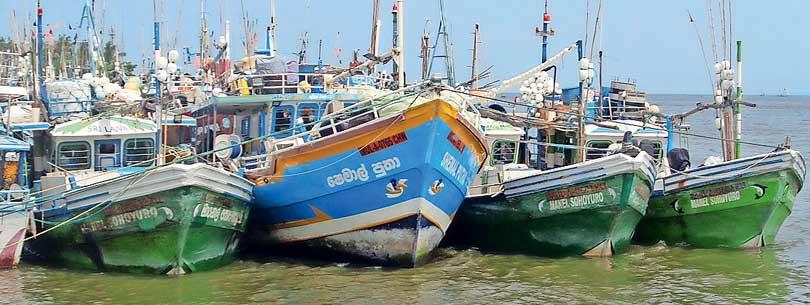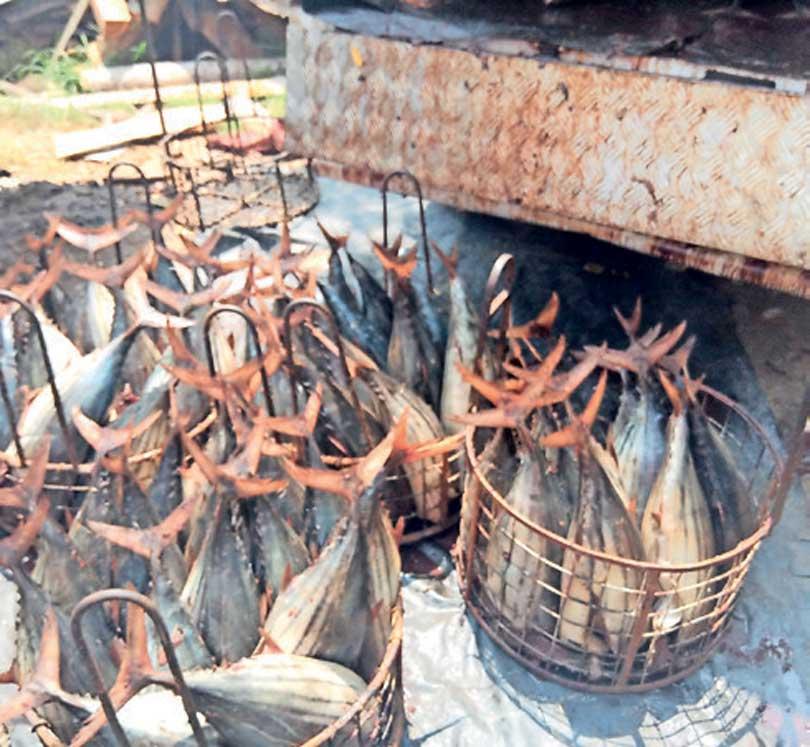05 Jan 2021 - {{hitsCtrl.values.hits}}
 Multi-day fishing boats in Negombo Harbour
Multi-day fishing boats in Negombo Harbour
 There is a widely held belief that the seas around Sri Lanka are full of fish. This conviction surfaced twice in the Daily Mirror last month. First, IGP C. D. Wickramasinghe banned serving ‘imported fish’ in the mess; instead the Police will purchase locally caught fish in pursuance of the government’s policy to reduce imports and support Sri Lankan fishermen (DM 21/12/2020).
There is a widely held belief that the seas around Sri Lanka are full of fish. This conviction surfaced twice in the Daily Mirror last month. First, IGP C. D. Wickramasinghe banned serving ‘imported fish’ in the mess; instead the Police will purchase locally caught fish in pursuance of the government’s policy to reduce imports and support Sri Lankan fishermen (DM 21/12/2020).
Afew days later the French Agency for Development (AFD) announced plans to introduce European based standards in four harbours that service Sri Lanka’s multi-day fishery sector on the south and west coasts (DM 25/12/20). The IGP’s orders and the AFD’s proposals are clearlywell intentioned, but both depend on an assumption - the seas around Sri Lanka are full of fish – that unfortunately is not true. Yes, Sri Lanka’s maritime exclusive economic zone (EEZ = 532,619 km2) is eight times its land area (65,610 km2). No, the seas within and beyond the EEZ are not teeming with fish.
Kelavalla (yellow fin tuna) and balaya (skipjack tuna) are the most important species caught by Sri Lanka’s large fleet of multi-day fishing boats. In 2015, the Indian Ocean Tuna Commission (IOTC) called for reductions of between 5% and 15% of the total catch of yellowfin tuna, based on total landings reported in 2014. According to IOTC’s analysts, catch reductions were (and remain) necessary, because there were not enough mature fish in the sea (the stock is over-fished) and too many kelavalla were being caught (the stock is subject to overfishing). Towards the end of last year, several international non-governmental organisations published reports calling for even bigger reductions in 2021 and beyond (20% - 30%); to rebuild spawning biomass and reduce overfishing of the yellowfin tuna stock. The IOTC adopted an annual catch limit for balaya in 2017 of 470,029MT, for the following three years. Recent assessments by IOTC’s analysts indicate that Indian Ocean fisheries for skipjack caught more than the catch limit in 2018 and then caught more than the limit again 2019. Too many balaya are still being caught, three years after the catch limit was introduced.
The status of Sri Lanka’s coastal fish stocks-harvested over or a little beyond the continental shelf - is not any better. Coastal fish production exceeded the maximum sustainable yield (≈245,000MT) in 2012, according to data published by the Ministry of Fisheries and Aquatic Resources (MFAR). More fish than can be harvested sustainably have been caught by coastal fishermen in six out of the past seven years (MFAR, 2019). A recent survey of the coastal ecosystem by the Norwegian Research Vessel Dr. Fridtjof Nansen indicated that the standing fish biomass has been significantly depleted over the past 40 years (NARA, 2018).
The present status of fish stocks in Sri Lankan waters and beyond can perhaps be understood best in the context of changes that have taken place in the fishery sector over the past 70 years. Nearshore beach seine and traditional boat fisheries in the 1950s and 60s evolved into coastal, motorized boat fisheries in the 1970s. In the 1970 and 80s, mechanized multi-day boats were added to the sector. Multi-day trawlers enabled fishermen to fish beyond the continental shelf up to the edge of the EEZ. Since the early 1990s the multi-day trawler fishery has continued to develop. Each year boat owners invest in slightly bigger boats to fish a little further beyond Sri Lanka’s EEZ in search of fish. Incremental changes in coastal and multi-day trawler fisheries over time are both a cause and a consequence of the seas around Sri Lanka no longer being full of fish.
On January 1, government officers swore allegiance to the Constitution and the new National Policy Framework (NPF –vistas of prosperity and splendour 2018). The NPF for fisheries (Chapter 5) seeks to achieve self-sufficiency in fishery products to ensure food security, while contributing to the national economy. The NPF’s strategy to achieve this is through the introduction of a fisheries development plan to provide nutrition to people, increase foreign exchange earnings and provide employment and livelihood opportunities.

Balaya being prepared for dry fish
The current status and potential of Sri Lanka’s coastal, offshore and beyond EEZ fisheries suggest that formulating this new plan will be neither simple nor straightforward. ‘Fisheries development’ is no longer synonymous with increasing production, building bigger or better boats or improving infrastructure. Regional and international pressure to reduce / maintain the catch of kelavalla/balaya will increase in 2021. The present level of coastal fish production does not appear to be sustainable.
Fish are of course natural, renewable resources. Fish stocks will and do recover. Managed effectively, fisheries can and do produce maximum sustainable yields; yields that in theory can be harvested indefinitely. Here then lies the challenge that awaits the government in 2021; how to frame a new fisheries development plan when the seas around Sri Lanka are no longer teeming with fish? The NDF’s policy of self-sufficiency in fishery products to ensure food security, while contributing to the national economy will not be achieved by wishful thinking. A different kind of thinking is required; one that gives priority to research, linked to collaborative management,over infrastructure and new technology. There are no quick fixes to unsustainable fisheries: degradation and rejuvenation of fishery resources both require commitment and continuity over time. Well informed decision by the government, involving fishermen, boat owners and the seafood industry will be essential if the government is to successfully develop fisheries that are sustainable by 2029.
The author is a freelance fisheries consultant and can be reached on [email protected]
30 Nov 2024 2 hours ago
30 Nov 2024 3 hours ago
29 Nov 2024 29 Nov 2024
29 Nov 2024 29 Nov 2024
29 Nov 2024 29 Nov 2024